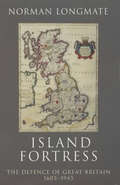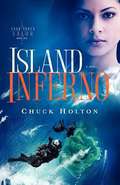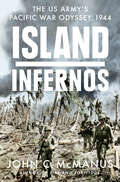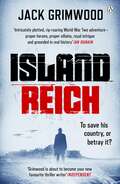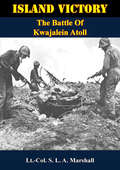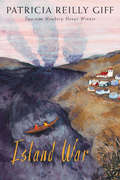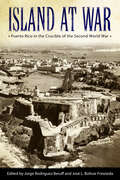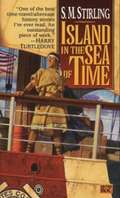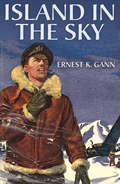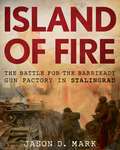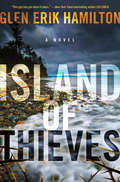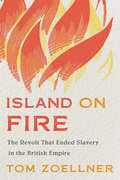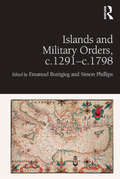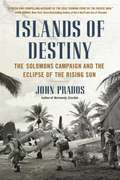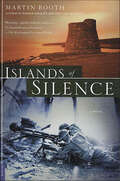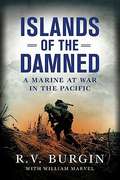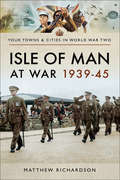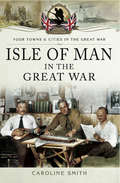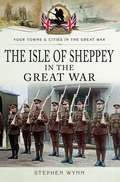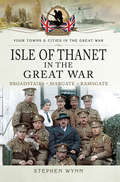- Table View
- List View
Island Deathtrap (Mack Bolan The Executioner #56)
by Don Pendleton[from the back cover] "Live Free or Kill! A foreign terrorist group had taken over a small island off the coast of Maine as a conduit for the importation of men and arms into the U.S. To ensure the secrecy of their hardsite, the criminals needed the help of the local lobstermen and independent fishermen. The mob had begun a campaign of terror aimed at wives and families to "soften up" the boatmen. One man, Ed Warner, had gotten through to Stony Man headquarters. Mack Bolan was determined to avenge the misery of Warner and his neighbors. He plunged head-on into the island deathtrap to grind hardened killers into minced meat.... And in his most perilous impersonation yet, Bolan breached the gang's defenses and became walking Death."
Island Fortress: The Defence of Great Britian 1606-1945
by Norman LongmateThe British Isles, it is often believed, have not been invaded for nearly a thousand years. In fact, as Norman Longmate reveals in this highly entertaining book (the successor to his acclaimed Defending the Island), foreign soldiers have landed on British soil on many occasions.In this definitive study of a long-neglected subject Norman Longmate make constant use of original sources, including contemporary eyewitness accounts. These are woven into an enthralling narrative, packed with fact - about weapons, ships, armies and fortresses - spiced with anecdote, and ranging over international and political as well as military and naval history. The result is above all an exciting story, which shows how, against all the odds, the British people managed to retain their freedom from the days of James I to those of George VI.
Island Inferno (Task Force Valor Series #2)
by Chuck HoltonTask Force Valor Explosive Ordnance Disposal--The Bomb Squad. As the global war on terror heats up, the U.S. deploys a team of highly trained special operators overseas to locate and neutralize threats, bringing EOD expertise to dangerous missions that have no room for error. A DEADLY EXPLOSIVE. A new specialty explosive is on the black market: ITEB looks like water, but when it's exposed to air, the effects are lethal! The United States government is frantic to keep it from our shores. Staff Sergeant Euripides "Rip" Rubio knows how destructive ITEB can be. He has already risked his life to thwart a horrific terrorist plot involving the chemical. Now Task Force Valor heads to Panama, on the trail of an arms dealer who plans to use ITEB to make a killing-literally. AN ADVENTURE ABROAD. Fernanda Lerida is a University of Panama grad student who jumps at the chance to join a biological expedition to a mysterious former prison island. But the snakes, bugs, and crocodiles are soon the least of her worries as the group stumbles upon something they were not meant to see. To make matters worse, Fernanda soon finds herself alone and being pursued by an unseen foe. A RISKY RESCUE. When Rip's path collides with Fernanda's, they find themselves caught in the midst of a brutal turf war. Can they use the chaos to their advantage, or will one false step set the entire island ablaze?
Island Infernos: The US Army's Pacific War Odyssey, 1944
by John C. McManusFrom the author of Fire and Fortitude, the continuation of the US Army's epic crusade in the Pacific War, from the battle of Saipan to the occupation of JapanJohn C. McManus's award-winning Fire and Fortitude enthralled readers with an unforgettable and authoritative account of the US Army's evolution during the Pacific War, from the devastation of Pearl Harbor to the bloody battle for Makin Island in 1943. Now, in this second and final volume, he follows the Army as they land on Saipan, Guam, and Okinawa, climaxing with the American return to the Philippines, one of the largest, most complex operations in American history and one that would eventually account for one-third of all American casualties in the Pacific-Asia theater.Brilliantly researched and written, the narrative moves seamlessly from the highest generals to the lowest foot soldiers and in between, capturing the true essence of this horrible conflict. It is a masterful history by one of our finest historians of World War II.
Island Reich: The atmospheric WWII thriller perfect for fans of Simon Scarrow and Robert Harris
by Jack GrimwoodAN UNLIKELY SPY. A FORMER KING. THE FATE OF A NATION IN THEIR HANDS.The gripping WWII thriller from the award-winning author of Nightfall Berlin, perfect for fans of Simon Scarrow'Intricately plotted, rip-roaring World War Two adventure - proper heroes, proper villains and grounded in real history' IAN RANKIN'Fact and fiction merge in a rip-roaring yarn that is totally credible. Excellent' SUN_________July, 1940. The Nazis launch their invasion of Britain - starting with the Channel Islands . . .And soldier turned safecracker Bill O'Hagan gets an offer: hang for his crimes, or serve his country.The mission - land on occupied Alderney, impersonate a local, steal the invasion plans, escape. He almost believes they're not lying to him.In Portugal, the former King, Edward, Duke of Windsor, receives an altogether different proposal from Germany: ease the invasion and he'll get his throne back. But Edward will not readily betray his country . . .An embittered former king. An unreformed thief.And a secret upon which the fates of nations lie . . ._________'Fact and fiction merge in a rip-roaring yarn that is totally credible. Excellent' SUN'Triumphant . . . The synthesis of real and fictitious characters is handled with panache by the talented Grimwood' FINANCIAL TIMES'Top notch . . . the suspense never wavers' CRIMETIME'Grimwood matches Robert Harris, Joseph Kanon, Ken Follett and John le Carré thrill for thrill in this breath-taking WWII story of atmospheric suspense, daring espionage and political intrigue' GLASGOW LIFE 'Highly entertaining . . . There are complications, twists and turns of plot in abundance. Every bit as credible or satisfying as James Bond' SCOTSMAN
Island Victory: The Battle Of Kwajalein Atoll
by Lt.-Col. Samuel L. A. MarshallAn on-the-spot history of a fight in the Pacific during World War II, Island Victory was the first battle history written by—then Lieutenant-Colonel—S. L. A. Marshall, a veteran of World War I who would serve in Korea and Vietnam and become a brigadier general in the process. After the Seventh Infantry Division drove across Kwajalein Atoll in the first days of February 1944, successfully wresting control of the strategic southern tip from the Japanese, Marshall was charged with producing an accurate and comprehensive account of the fight. His solution: bring the front-line soldiers together at once and interview them as a group, tapping the collective memory of a platoon fresh from battle.In this book, readers get a rare, first-hand sense of all the emotions that soldiers in combat experience. Numerous maps and photographs help us visualize precisely what took place. A compelling work of military history, and the first book of its kind, Island Victory is itself an important chapter in the history of how military exploits are described and recorded.—Print Ed.
Island War
by Patricia Reilly GiffA boy and girl must survive on their own on a remote Japanese-occupied island during World War II. Fans of Hatchet and Julie of the Wolves will be riveted by the story of 11-year-old Izzy and 14-year-old Matt who are left alone on an Alaskan island when the Japanese army takes the rest of the Americans prisoner. Now that Izzy's ornithologist mother, Matt's father, and the other villages have been evacuated to camps in Japan, Izzy and Matt become the only Americans left on the island. They must rely on themselves to hide from the Japanese soldiers, keep their dog for giving them away, survive the harsh winter and Allied bombing raids. A thrilling novel of kids with grit and ingenuity.
Island at War: Puerto Rico in the Crucible of the Second World War (Caribbean Studies Series)
by Jorge Rodríguez BeruffDespite Puerto Rico being the hub of the United States' naval response to the German blockade of the Caribbean, there is very little published scholarship on the island's heavy involvement in the global conflict of World War II. Recently, a new generation of scholars has been compiling interdisciplinary research with fresh insights about the profound wartime changes, which in turn generated conditions for the rapid economic, social, and political development of postwar Puerto Rico. The island's subsequent transformation cannot be adequately grasped without tracing its roots to the war years. Island at War brings together outstanding new research on Puerto Rico and makes it accessible in English. It covers ten distinct topics written by nine distinguished scholars from the Caribbean and beyond. Contributors include experts in the fields of history, political science, sociology, literature, journalism, communications, and engineering. Topics include US strategic debate and war planning for the Caribbean on the eve of World War II, Puerto Rico as the headquarters of the Caribbean Sea frontier, war and political transition in Puerto Rico, the war economy of Puerto Rico, the German blockade of the Caribbean in 1942, and the story of a Puerto Rican officer in the Second World War and Korea. With these essays and others, Island at War represents the cutting edge of scholarship on the role of Puerto Rico and the Caribbean in World War II and its aftermath.
Island in the East: Escape This Summer With This Perfect Beach Read
by Jenny Ashcroft***THE EBOOK BESTSELLER***Perfect for fans of Lucinda Riley, Dinah Jefferies, Victoria Hislop and Lucy Foley.Two great loves. One shattering betrayal.A war that changes everything.**************'Island in the East is a stunner' Kate Furnivall'Exotic and mysterious - I was gripped' Dinah Jefferies'A moving, stirring love story' Rachel Rhys'Evocative, absorbing. . . A rich and satisfying read' Gill Paul'It becomes impossible to put this book down' Kate Riordan**************Singapore, 1897 Harriet and Mae Grafton are twenty-year-old identical twins born from a scandalous affair. They grew up in India slighted by gossip and ostracised from polite society. They had each other and that was enough. But when their wealthy benefactor sends them to Singapore, they meet the mysterious Alex Blake and their relationship fractures with devastating consequences.1941 Ivy Harcourt is posted to wartime Singapore amid the looming threat of Japanese invasion. Ivy knows the island will be a far cry from war-torn London, but she is totally unprepared for what awaits her: strangers from her grandmother Mae's past, an unstoppable love affair and a shattering secret that's been waiting to be uncovered . . .Vivid, authentic and utterly beautiful - with a sizzling love affair playing out against sisterly rivalry and epic family drama - Island in the East is romantic historical fiction at its very best.More praise for Jenny Ashcroft:'Beautifully described . . . A moving love story' Tracy Rees'A great read.' Judith Lennox'A summer must-read' Red'Love, sisterly rivalry and betrayal are themes in this epic tale'My Weekly'Brilliant; everything romantic historical fiction should be.' Nicola Cornick'Absolutely brilliant' Kerry Fisher'Completely entrancing . . . Perfect escapism, beautifully written.' Emma Rous'Evocative, lush and beautifully written, Island in the East is a gripping read.' Nikola Scott'First-class writing, brilliant characters, fascinating locations and gripping plots' Tracy Buchanan'Exquisitely written . . . unputdownable and unforgettable' Iona Grey'A wonderful novel, full of mystery that kept me gripped until the end' Rachel Burton
Island in the East: Escape This Summer With This Perfect Beach Read
by Jenny Ashcroft***THE EBOOK BESTSELLER***Perfect for fans of Lucinda Riley, Dinah Jefferies, Victoria Hislop and Lucy Foley. Two great loves. One shattering betrayal.A war that changes everything.**************'Island in the East is a stunner' Kate Furnivall'Exotic and mysterious - I was gripped' Dinah Jefferies'A moving, stirring love story' Rachel Rhys'Evocative, absorbing. . . A rich and satisfying read' Gill Paul'It becomes impossible to put this book down' Kate Riordan**************Singapore, 1897 Harriet and Mae Grafton are twenty-year-old identical twins born from a scandalous affair. They grew up in India slighted by gossip and ostracised from polite society. They had each other and that was enough. But when their wealthy benefactor sends them to Singapore, they meet the mysterious Alex Blake and their relationship fractures with devastating consequences. 1941 Ivy Harcourt is posted to wartime Singapore amid the looming threat of Japanese invasion. Ivy knows the island will be a far cry from war-torn London, but she is totally unprepared for what awaits her: strangers from her grandmother Mae's past, an unstoppable love affair and a shattering secret that's been waiting to be uncovered . . .Vivid, authentic and utterly beautiful - with a sizzling love affair playing out against sisterly rivalry and epic family drama - Island in the East is romantic historical fiction at its very best.More praise for Jenny Ashcroft:'Beautifully described . . . A moving love story' Tracy Rees'A great read.' Judith Lennox'A summer must-read' Red'Love, sisterly rivalry and betrayal are themes in this epic tale' My Weekly'Brilliant; everything romantic historical fiction should be.' Nicola Cornick'Absolutely brilliant' Kerry Fisher'Completely entrancing . . . Perfect escapism, beautifully written.' Emma Rous 'Evocative, lush and beautifully written, Island in the East is a gripping read.' Nikola Scott'First-class writing, brilliant characters, fascinating locations and gripping plots' Tracy Buchanan'Exquisitely written . . . unputdownable and unforgettable' Iona Grey'A wonderful novel, full of mystery that kept me gripped until the end' Rachel Burton
Island in the East: Escape This Summer With This Perfect Beach Read
by Jenny Ashcroft***THE EBOOK BESTSELLER***Perfect for fans of Lucinda Riley, Dinah Jefferies, Victoria Hislop and Lucy Foley. Two great loves. One shattering betrayal.A war that changes everything.**************'Island in the East is a stunner' Kate Furnivall'Exotic and mysterious - I was gripped' Dinah Jefferies'A moving, stirring love story' Rachel Rhys'Evocative, absorbing. . . A rich and satisfying read' Gill Paul'It becomes impossible to put this book down' Kate Riordan**************Singapore, 1897 Harriet and Mae Grafton are twenty-year-old identical twins born from a scandalous affair. They grew up in India slighted by gossip and ostracised from polite society. They had each other and that was enough. But when their wealthy benefactor sends them to Singapore, they meet the mysterious Alex Blake and their relationship fractures with devastating consequences. 1941 Ivy Harcourt is posted to wartime Singapore amid the looming threat of Japanese invasion. Ivy knows the island will be a far cry from war-torn London, but she is totally unprepared for what awaits her: strangers from her grandmother Mae's past, an unstoppable love affair and a shattering secret that's been waiting to be uncovered . . .Vivid, authentic and utterly beautiful - with a sizzling love affair playing out against sisterly rivalry and epic family drama - Island in the East is romantic historical fiction at its very best.More praise for Jenny Ashcroft:'Beautifully described . . . A moving love story' Tracy Rees'A great read.' Judith Lennox'A summer must-read' Red'Love, sisterly rivalry and betrayal are themes in this epic tale' My Weekly'Brilliant; everything romantic historical fiction should be.' Nicola Cornick'Absolutely brilliant' Kerry Fisher'Completely entrancing . . . Perfect escapism, beautifully written.' Emma Rous 'Evocative, lush and beautifully written, Island in the East is a gripping read.' Nikola Scott'First-class writing, brilliant characters, fascinating locations and gripping plots' Tracy Buchanan'Exquisitely written . . . unputdownable and unforgettable' Iona Grey'A wonderful novel, full of mystery that kept me gripped until the end' Rachel Burton
Island in the Sea of Time (Island #1)
by S. M. StirlingIt's spring on Nantucket and everything is perfectly normal, until a sudden storm blankets the entire island. When the weather clears, the island's inhabitants find that they are no longer in the late twentieth century...but have been transported instead to the Bronze Age! Now they must learn to survive with suspicious, warlike peoples they can barely understand and deal with impending disaster, in the shape of a would-be conqueror from their own time.
Island in the Sky (Island In The Sky Ser. #No. 6)
by Ernest K. GannIsland in the Sky, first published in 1944, is aviator Ernest Gann’s exciting, realistic novel of survival in the far north of Canada. The Corsair, a plane attached to the Army Air Transport Command during the Second World War, is forced to land after heavy icing of the wings makes the plane unflyable. The crew look to Dooley, the pilot for guidance in order to survive the frigid conditions, and from support bases and search aircraft, a rescue mission is mounted. Island in the Sky was the subject of a 1953 movie starring John Wayne.Publisher’s Note, Nov. 26, 2015: Note that a recent reviewer’s comment stating that the book ‘lacks many parts...including the entire completion” is not accurate. Our editions of Island in the Sky contain the full and complete text of the book as written by author Ernest Gann.
Island of Fire: The Battle for the Barrikady Gun Factory in Stalingrad
by Jason D. MarkStalingrad was one of the largest, bloodiest, and most famous battles in history as well as one of the major turning points of World War II. For four winter months during the battle, German and Soviet forces fought over a single factory inside the city of Stalingrad. Lavishly illustrated with photos and maps, Island of Fire presents a day-by-day—at times hour-by-hour—chronicle of that pitiless struggle as seen by both sides. The book is unparalleled and exhaustive in its research, meticulous in its reconstruction of the action, and vivid in its retelling of the street-by-street, hand-to-hand fighting near the gun factory.
Island of Sweet Pies and Soldiers: A Novel (Mira Ser.)
by Sara Ackerman&“A close-up look at how wartime chaos affects a tight-knit group of women living on Hawaii in 1944 at the height of Pacific combat.... [Violet&’s] journey overcoming her trials and grief through friendship, family, and romance is a story of strength and perseverance.&”—BooklistViolet Iverson and her young daughter, Ella, are piecing their lives together after the disappearance of her husband. As rumors swirl and questions about his loyalties surface, Violet believes Ella knows something. But Ella is stubbornly silent. Something—or someone—has scared her.With the island overrun by troops training for a secret mission, tension and suspicion between neighbors is rising. To get through the difficult days, Violet bands together with her close friends and they open a pie stand near the military base, offering the soldiers a little homemade comfort.Try as she might, Violet can&’t ignore her attraction to the brash marine who comes to her aid when the women are accused of spying. Desperate to discover the truth behind what happened to her husband, while keeping her friends and daughter safe, Violet is torn by guilt, fear and longing as she faces losing everything. Again.Don't miss THE GUEST IN ROOM 120, Sara Ackerman's enthralling new novel with dual-timelines intertwining a 1905 mystery surrounding Jane Stanford's mysterious death in Honolulu and a 2005 writer's quest to uncover the truth at the same historic hotel...More captivating stories from Sara Ackerman: The Maui Effect The Unchartered Flight of Olivia West The Codebreaker's Secret Radar Girls Red Sky Over Hawaii The Lietenant's Nurse&“A bittersweet story of cinematic proportions.&”—BookPage
Island of Thieves: A Novel
by Glen Erik Hamilton“Hamilton has never been better.” —Publishers Weekly (starred review) When a new security gig turns into a setup, expert thief Van Shaw finds himself the prey in a cross-country pursuit—in this electrifying sixth novel in Glen Erik Hamilton’s pulse-pounding and emotionally resonant thriller series. Van Shaw is hired to evaluate the safeguards for the art collection of eccentric business magnate Sebastien Rohner. Then Rohner reveals to Van the real reason he’s been recruited: to prevent another professional burglar from stealing the art. Rohner wants to set a thief to catch a thief.While questioning the bizarre nature of the job, Van accepts the lucrative offer and arrives at the island estate during an international summit that Rohner is hosting. Shortly after beginning his surveillance of Rohner’s highly secure gallery wing, Van stumbles across the murdered body of one of the honored guests along the rocky shore. Wary of Rohner’s true intentions, Van knows the homicide detectives on the case—and perhaps Rohner as well—believe he’s the prime suspect and will turn his life upside down in their search for proof.Van begins to hunt for the murderer himself, but scrutiny only digs his hole deeper, as one of Rohner’s own executives is also killed and the Seattle police find concrete evidence placing Van at the scene. With no other options, he goes on the run, alone and unaided. He’s hunted by the cops, the enraged Rohner, and by a pair of psychopathic hitmen who chase Van from one coast to the next. To clear his name, Van Shaw will have to uncover the hidden motive of corporate espionage at a global level, even with a band of killers on his tail, determined to add Van to their growing list of victims.
Island on Fire: The Revolt That Ended Slavery in the British Empire
by Tom ZoellnerFrom a New York Times bestselling author, a gripping account of the slave rebellion that led to the abolition of slavery in the British Empire. For five horrific weeks after Christmas in 1831, Jamaica was convulsed by an uprising of its enslaved people. What started as a peaceful labor strike quickly turned into a full-blown revolt, leaving hundreds of plantation houses in smoking ruins. By the time British troops had put down the rebels, more than a thousand Jamaicans lay dead from summary executions and extrajudicial murder. While the rebels lost their military gamble, their sacrifice accelerated the larger struggle for freedom in the British Atlantic. The daring and suffering of the Jamaicans galvanized public opinion throughout the empire, triggering a decisive turn against slavery. For centuries bondage had fed Britain’s appetite for sugar. Within two years of the Christmas rebellion, slavery was formally abolished. Island on Fire is a dramatic day-by-day account of this transformative uprising. A skillful storyteller, Tom Zoellner goes back to the primary sources to tell the intimate story of the men and women who rose up and tasted liberty for a few brief weeks. He provides the first full portrait of the rebellion's enigmatic leader, Samuel Sharpe, and gives us a poignant glimpse of the struggles and dreams of the many Jamaicans who died for liberty.
Islands and Military Orders, c.1291-c.1798
by Simon Phillips Emanuel ButtigiegAt the heart of this volume is a concern with exploring levels of interaction between two particular objects of study, islands on the one hand, and military orders on the other. According to Fernand Braudel, islands are, ’often brutally’, caught ’between the two opposite poles of archaism and innovation.’ What happened when these particular environments interacted with the Military Orders? The various contributions in this volume address this question from a variety of angles. 1291 was a significant year for the main military orders: uprooted from their foundations in the Holy Land, they took refuge on Cyprus and in the following years found themselves vulnerable to those who questioned the validity of their continued existence. The Teutonic Order negated this by successfully transferring their headquarters to Prussia; the Knights Templar, however, faced suppression. Meanwhile, the Knights Hospitaller conquest of Rhodes assured both their survival and independence. Islands are often, by definition, seen to be embodiments of 'insularity', of an effort to be separate, distinct, cut-off. Military Orders are, conversely, international in scope, nature and personnel, the 'first international orders of the Church', as they have often been described. Therein lies the crux of the matter: how did insular outposts and international institutions come together to forge distinct and often successful experiments? Hospitaller Rhodes and Malta still impress with their magnificent architectural heritage, but their success went beyond stone and mortar and the story of islands and military orders, as will be clearly shown in this volume, also goes beyond these two small islands. The interaction between the two levels - insulation and internationalisation - and the interstices therein, created spaces conducive to both dynamism and stability as military orders and islands adapted to each other's demands, limitations and opportunities.
Islands of Destiny: The Solomons Campaign and the Eclipse of the Rising Sun
by John PradosAcclaimed WWII historian and military intelligence expert John Prados offers a provocative reassessment of the Allies’ battle for the Solomon Islands—a turbulent, dramatic campaign that, he argues, was the true turning point of the Pacific conflict. Historians traditionally refer to the Battle of Midway as the point when Allied forces gained the advantage over the Japanese. In Islands of Destiny, Prados points out that the Japanese forces quickly regained strength after Midway and continued their assault undaunted. Taking this surprising fact as the start of his inquiry, he began to investigate how and when the Pacific tide turned in the Allies’ favor. His search led him to the decisive battles and strategic maneuvers in the fight for the Solomon Islands. Beginning with the invasion of Guadalcanal in August 1942, the Solomons became a hotly contested battleground for over a year, culminating in the isolation of Rabaul by the Allies. As military forces fought over the strategically important islands, a secret war of intelligence was also being waged. For a total picture of the conflict, Prados integrates blow-by-blow action on the ground with the code breaking, aerial reconnaissance, secret spy posts, and submarine scouting that were vital to the Allied effort. The Solomons arena saw some of the most intense combat of WWII—from major naval actions, including a key confrontation between battleships, to air battles that took place almost daily. With expert knowledge and crystal clear prose, John Prados illustrates why these events were not only thrilling, but pivotal in the Allies’ path to victory. .
Islands of Silence: A Novel
by Martin BoothIslands of Silence is the story of the young Alec Marquand, who in the summer of 1914 has just graduated from college with a degree in archaeology. He has been hired by the lord of a remote country estate in the Scottish Highlands to survey the ancient Stone Age brochs that lie on his property. Once there Alec comes upon a small island which is called Eilean Tosdach--the Island of Silence. What Alec discovers on that island changes him forever. And just as Alec makes his amazing find, he is shipped off to war . . . a war he does not want to fight, but one in which he ends up as a medic aboard a ship ready to storm the beaches of Gallipoli.A brilliantly crafted novel in the tradition of All's Quiet on the Western Front and The Ghost Road, Islands of Silence is a tour through one man's hell in search of a path for redemption.
Islands of the Damned: A Marine at War in the Pacific
by Burgin R. V.One of the real-life heroes featured in HBO(r)'s The Pacific tells his own true story. R. V. Burgin reveals his experiences as a Marine at war in the Pacific Theater, where Company K confronted snipers, ambushes along narrow jungle trails, abandoned corpses of hara-kiri victims, and howling banzai attacks as they island-hopped from one bloody battle to the next. During his two years of service, Burgin rose from a green private to a seasoned sergeant, and earned a Bronze Star for his valor at Okinawa. With unforgettable drama and an understated elegance, Burgin's gripping narrative chronicles the waning days of World War II, bringing to life the hell that was the Pacific War. .
Isle of Man at War, 1939–45 (Your Towns And Cities In World War Two Ser.)
by Matthew RichardsonIsle of Man at War 1939-45 presents the remarkable story of the Manx people, and their homeland, in the most destructive conflict of the twentieth century. Few people are now aware of the extraordinary role that this small island played in assisting the allied war effort. Yet for six years, a place best known for motorcycle racing and as a holiday playground became a heavily armed fortress. Hundreds of airmen, soldiers and sailors were trained in readiness for combat. Thousands of enemy aliens were imprisoned behind the barbed wire of its camps, alongside those of British birth who were deemed to be a threat to security. Top secret radar was developed, and the Island's merchant fleet played a vital role at Dunkirk and D-Day. On battlefields around the world, gallant Manxmen fought bravely, whilst at home, in spite of the pressures which total war brought to society, there was a perhaps surprising tolerance for those with pacifist beliefs. Likewise, though there was increased government control in almost all areas of life, these were times of great advancement for Manx democracy. The story is told in the words of those who were there - some of these eyewitnesses speaking for the first time about their experiences, and among them the last survivors of that generation. Their accounts bring a freshness and immediacy to this remarkably vivid narrative.
Isle of Man in the Great War (Your Towns & Cities in the Great War)
by Caroline SmithIn August 1914, the Isle of Man was in the middle of a very successful summer season. The tourist industry was crucial to the island, but suddenly holiday-makers left and the Steam Packet vessels that normally brought them were requisitioned. The future was uncertain for those who relied on the season and their pleas for assistance were ignored. For some, the cost of living became impossibly high and without the welfare measures that had been brought about in Britain, many faced destitution. Others however, particularly farmers and those involved with the internment camps, would find war very profitable. The divisions between rich and poor grew creating much social disaffection and a bitter battle for reform was fought. As arguments raged over conscription, taxation, the economy and the housing of enemy aliens, the personalities of the period came to prominence. The unprecedented scenes of direct action and several dramatic court cases are brought to life in this account of how the island began its path to progress.The Isle of Man played an important role in World War One, supplying troops and vessels and running special camps for the internment of enemy. 8,261 men enlisted in the armed forces, which was 82.3% of the Isle of Man's male population of military age. Of these, 1,165 gave their lives and 987 were wounded.The experience of war significantly impacted on the Island, from the initial enthusiasm for sorting out the German Kaiser in time for Christmas 1914, to the gradual realization of the enormity of human sacrifice the families of the Isle were committed to as the war stretched out over the next four years. The Great War affected everyone. At home there were wounded soldiers in military hospitals, refugees from Belgium and later on German prisoners of war. There were food and fuel shortages and disruption to schooling. The role of women changed dramatically and they undertook a variety of work undreamed of in peacetime. Extracts from contemporary letters reveal their heroism and give insights into what it was like under battle conditions.
Isle of Sheppey in the Great War (Your Towns And Cities In The Great War Ser.)
by Stephen WynnThe Isle of Sheppey, although not a heavily populated area, played an extremely important part in Great Britains war effort on the home front throughout the four and a half years of the First World War. In doing so, Sheppey provided protection for the Thames Estuary, the River Medway and the naval shipyards at both Sheerness and Chatham. Its defensive emplacements largely responsible for acquiring the nickname locally of the 'Barbed Wire Island.'One of its main claims to fame in relation to the years of the First World War would have undoubtedly been in relation to aviation. The island had been a hive of activity in relation to flying since the beginning of the twentieth century, when the Royal Aero Club came to Leysdown, making it the first airfield in England. What became Eastchurch Aerodrome was where the first pilots of the Royal Naval Air Service were trained, making it the first military flying school in the country. The Short brothers also had an aircraft factory at Eastchurch where they designed and built their own aircraft, some of which would be used during the First World War.The Isle of Sheppey also boasted another aircraft factory, which was situated at Shellbeach on the east coast of the island, an emergency landing strip at Harty on the south east side of the island, and a balloon station at Sheerness.The First World War certainly saw the Isle of Sheppey rise to the occasion and add to its long and illustrious military history. The part it played went a long way in enhancing the islands reputation of having a dogged determination to do what needed to be done for the greater good in the nations time of need.
Isle of Thanet in the Great War: Broadstairs—Margate—Ramsgate (Your Towns And Cities In The Great War Ser.)
by Stephen WynnBecause of the geographical location of the Isle of Thanet, it was always going to play a part in the First World War. For some wounded British and Commonwealth troops returning from the fighting in France and Belgium, it was their first sight of England in months. The Isle of Thanet just happened to be on one of the routes German Zeppelins and Gotha Bombers took on their way to try and bomb London, which meant that parts of the district were always going to be vulnerable from a sudden and unexpected attack from the air.The Isle of Thanet not only provided thousands of men for service in the armed forces, but hundreds of men and women to serve in the Voluntary Aid Detachments that were greatly needed, not just throughout the Isle of Thanet, but all over Kent, to help deal with the steady influx of returning wounded soldiers from across the English Channel.Members of local Territorial units, the 4th Battalion, The Buffs (East Kent Regiment) and the 3rd (Kent) Battalion, Royal Field Artillery, were quickly mobilized for war time service, during the early days of the war, suddenly making everything so very real for those concerned.Many of the districts Police Constables, were ex-servicemen, some of whom were still on the Army Reserve, they too were called up to once again go and serve with the colors.There was a great clamor across the country with everybody wanting to do their bit in what ever way they could, the people of the Isle of Thanet were no different. By the end of the war, they had certainly played their part in ensuring that the outcome was a victorious one, making the sadness of the ones who had paid the ultimate price, slightly easier to accept.

